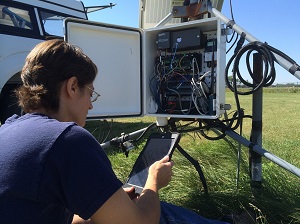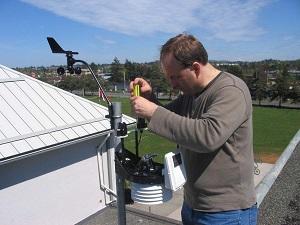
Maintenance of the weather station pieces of equipment is very important. The various equipment in the weather station must be maintained properly in order to ensure the accuracy of the data and reports provided by the weather station and as well as its durability. To be able to provide good data quality, the weather station must be in good condition. There are many types of equipment in the unit that needs routine checkup and calibration tests. The user must never ignore this part, as the accuracy of the weather station totally depends on the maintenance.
Here are some of the general guidelines that may help the user in properly maintaining the weather station.
Console maintenance
The console should be kept properly. It must not be exposed to sunlight. If the console has attached sensors, it must be kept away from heat and cold source. The batteries of the console should be changed whenever necessary, especially if the brightness becomes weak. The console should never be dropped, as this might cause permanent damage to the display as well as the technical system of the console. The adapter cable of the sensor should be checked if there is any structural damage and it should be replaced if necessary. The console must be kept out of reach from the children.
See More About This AcuRite 01024M Pro Weather Station
Sensor unit maintenance
Sensors are the vital parts of the weather station, as these are the ones that transmit the data of the different weather variables to the console. It is very much important that the sensors are working properly and are in good condition.
- Pole
The pole or the tripod where the whole sensor unit is installed must be checked in every 6 months. One should check the level and alignment. If there is any structural or physical damage then the pole must be replaced immediately. Any grass around the weather station pole should be mowed down in every 1 month time interval, in order to expose the wirings. During mowing down the grasses, one needs to be careful not to cut or ruin any wiring and should be extra careful about the rain gauge and soil temperature probe. Any adjacent structures near the weather station which might affect the sensors of the weather station that can indirectly hamper the measurements provided by the sensors must be checked. If required, the structures must be removed and if it is not possible, then the weather station sensor unit can be relocated.
- Cable
In case the weather station is cabled, the wiring cable connections must be checked routinely in every 3 to 4 months. Due to the weather conditions and exposure to sun and rain, the cable might be damaged. If any external damage on the cable is noticed then the cable must be replaced. The excess cable should be tied together, as this can create a mess and it might also affect the accuracy of the weather station.
- Desiccant
Desiccant is a very important substance; it is used as a drying agent in the data logger enclosure. The humidity indicator card must be checked in every 1 month time interval. The desiccant packs should be changed if the humidity inside the enclosure becomes more than 35%. The humidity indicator card needs to be replaced after every 2 to 3 years. The sealing of the data logger enclosure and the access hole for wiring should be checked carefully if the sealing is properly done, in order to prevent pest entry and unnecessary condensation inside the enclosure.
- Temperature and relative humidity sensors
The leads of the sensors should be checked for any damage and deterioration in every 6 months. It must be made sure that routing is proper and free from any strain. The temperature and humidity sensors should be cleaned with distilled water. Any debris like dust, webs, etc should be removed from the radiation shield. For recalibration, the temperature and humidity sensors must be sent to the manufactures every 12 months.
- Anemometer
Visual or audio inspection at low wind speed should be done in every 1 month’s time interval. If the anemometer delivers any unusual humming sound or rotation, then there might be some problems with the bearings of the anemometer. One must check for any cracks or damage on the leads of the anemometer and must make sure that the anemometer has proper routing and it is free from strain.
The bearings of the anemometer should be replaced after every 1 year and the wind vane potentiometer with bearings needs to be replaced after every 2 to 2 and a half years. The replacing of the anemometer parts must be always conducted by an experienced technician or by the manufacturer itself.
- Rain gauge
The rain gauge must be checked in every 1 month time interval. Any debris like leaves, insects, dust, etc must be removed from the funnel of the rain gauge. The throat opening of the rain gauge should be checked for proper leveling. The leads of the sensor must be checked if there is any crack or damage. The routing should be proper and the sensor should be free of any strain. The rain gauge must be recalibrated after every 12 months and this must be conducted by an experienced technician or by the manufacturer.
- UV radiation sensor
The solar radiation sensor must be checked routinely in every 1 month’s time interval. The level of the sensor can be checked with the help of the leveling bubble that is located on the base plate of the radiation sensor, and the screws must be adjusted if necessary. Any dust or debris on the sensor head should be removed by using compressed air or a soft bristle brush. The drain hole next to the surface of the sensor must be checked of any debris and should be cleaned. the leads of the sensor should be checked if there is any cracking or deterioration and it must have proper routing and should be free of strain. The solar radiation sensor must be sent to the manufacturer for re-calibration after every 2 years.
Power supply maintenance
Without an appropriate power supply, nothing works, the power supply is a must in the weather station. If the power is low, the unit won’t work properly and without proper operation, no accurate data will be provided.
- Solar panel
If the weather station is solar powered, the panel must be checked in every 3 month time interval. The orientation must be checked and adjusted for proper tilt and direction. The glass of the solar panel should be checked more often and needs to be cleaned with a soft and slightly moistened cloth because if the glass is dusty it can reduce the power output of the solar panel. One should never use abrasive pad or cleaner as these might put a scratch and permanently damage on the glass of the solar panel.
One must make sure that no part of the solar panel is covered in the shade while the rest of the part is exposed to sunlight, as this may permanently damage the solar panel. The solar panel must always be faced in the south direction. Tree branches that are likely to provide shade to the solar panel should be removed. Plants or trees that are growing around the pole or tripod holding the weather station solar panel unit must be removed, as these might cause problems later in the future.
If any problem is suspected with the output of the solar panel, then the voltage can be checked by using a voltmeter, placing it between the two leads of the solar panel and connecting a load to the solar panel. The voltage measured in the voltmeter must range from 11.5 volts to 14.5 volts. If the voltage is out of the given range, then there is s a problem in voltage regulator of the solar panel and it must be checked by an experienced technician or it can be sent to the manufacturer for repair.
- Battery
The battery is very important for storage of power. If a lead-acid battery is used, it needs a lot of maintenance. The top of the battery needs to be cleaned regularly to prevent any acid mist accumulation on the top of the battery, as this can result in high self-discharging of the battery. The terminals of the battery should be cleaned often to avoid any corrosion on the terminal and to ensure a good connection of the battery with the appliance. The terminals should be greased regularly to prevent corrosion. If in case the corrosion is severe, then the terminal connectors of the battery must be replaced immediately.
If any problem with the voltage of the battery is suspected, then the voltage must be checked by using a voltmeter between the poles of the battery. The voltage output of the battery in the voltmeter should be in the range from 11.5 volts to 13.5 volts. If the value of the voltage is out of the given range then there must be a problem with either insufficient recharge from the solar panel of the weather station or the battery may be faulty. In case the solar panel is all okay, then the battery needs to be replaced as soon as possible.
Conclusion
Proper maintenance of all the equipment is very important. Even though the maintenance has had been done the best way possible, the weather station too has a durability limit. Like any other technical system, the weather station also has its expiry. The warranty and durability time is always provided while purchasing the weather station. If any equipment gets damaged in its warranty period then one can get it repaired from the manufacturer for free of cost, but if the warranty has expired and any equipment is damaged, then the user will have to pay for the repair. If any of the types of equipment are damaged and the repairing cost would be almost the same as getting a new one, then it is best to replace the whole unit. One must always calculate and compare the repairing cost, as it is a wise decision to get a new weather station to replace the old one if it has crossed the durability period.
If you are new, see this weather stations reviews before buying one.

maintenance for any other meteorological instruments